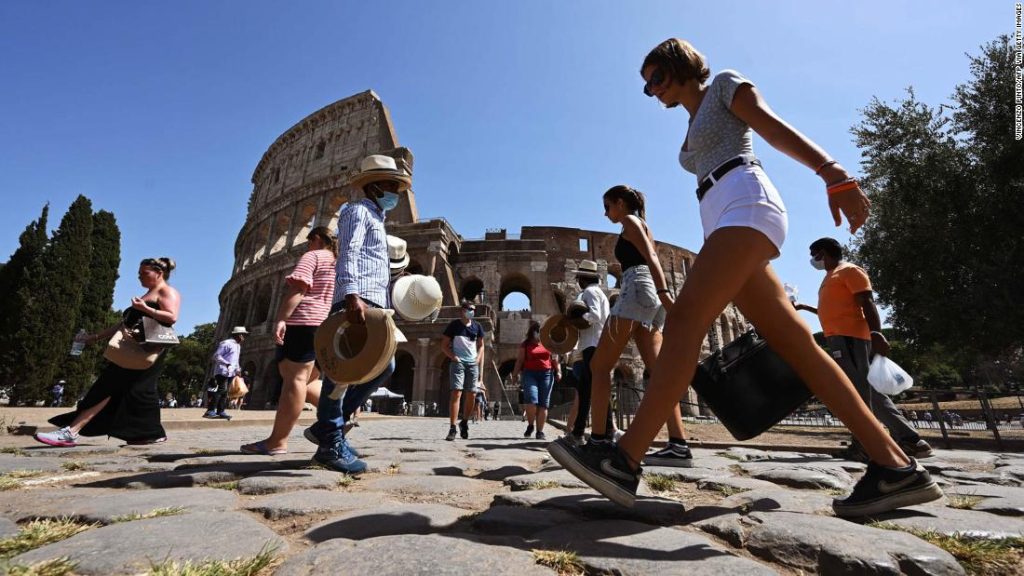Traveling to Italy during Covid-19: What you need to know before you go

Editor’s Note — Coronavirus cases are in flux across the globe. Health officials caution that staying home is the best way to stem transmission until you’re fully vaccinated. Below is information on what to know if you still plan to travel, last updated on February 9.(CNN) — If you’re planning to travel to Italy, here’s what you’ll need to know and expect if you want to visit during the Covid-19 pandemic. The basicsItaly renewed its state of emergency status on December 14 and will remain so until at least March 31. Case numbers are being continuously monitored, and regions are following a traffic light-style system with varying restrictions dependent on hospital capacity and infection rates.New restrictions on entry have been brought in, including testing requirements for EU arrivals for the first time. Entry is largely limited to residents of the European Union, plus a select list of non-EU countries, including the United States, Canada, Japan and the United Kingdom. The entry regulations differ depending on a traveler’s vaccination status and whether they’ve recently recovered from Covid.Since December 6, a tightening of rules means it is now difficult for unvaccinated people to carry out day-to-day activities. Masks must be worn at all times, including outside.What’s on offer in ItalyThis is one of Europe’s big hitters, known for its historic cities of art such as Florence, one-off wonders such as Venice and the seat of the Roman Catholic Church in Rome. Incredible food, fantastic wine, unspoiled countryside and a string of beach resorts mean it’s always in demand. Who can goItaly’s borders have been open to visitors since early 2021, with some restrictions in place. The rules were last updated on February 1 and are valid until March 15.List C is for Europe: Andorra, Austria, Belgium, Bulgaria, Cyprus, Croatia, Denmark (including Faroe Islands and Greenland), Estonia, Finland, France (including Guadalupe, Martinique, Guyana, Reunion and Mayotte), Germany, Greece, Hungary, Iceland, Ireland, Latvia, Liechtenstein, Lithuania, Luxembourg, Malta, Monaco, the Netherlands, Norway, Poland, Portugal (including the Azores and Madeira), Czech Republic, Romania, Slovakia, Slovenia, Spain, Sweden and Switzerland. List D, which was updated on February 1, now comprises the following countries: Argentina, Australia, Saudi Arabia, Bahrain, Canada, Chile, Colombia, UAE, Indonesia, Japan, Israel, Kuwait, New Zealand, Peru, Qatar, Rwanda, UK, South Korea, USA, Uruguay, Taiwan, Hong Kong and Macao. Note that Kosovo has been removed from this list.The rest of the world is classified as List E. Only essential travel is allowed from these destinations. However, leisure travel is allowed from Aruba, Cuba, Dominican Republic, French Polynesia, Maldives, Mauritius, Oman, Phuket (Thailand), Seychelles, Sharm El Sheikh and Marsa Alam (Egypt), Singapore and Turkey on “Covid-free touristic corridors.” The criteria for this is strict: Travelers must travel in a controlled group with specific tour operators, staying in government-selected accommodation. See below for entry regulations. On January 14, Italy lifted the travel ban on arrivals from eight southern African countries: South Africa, Lesotho, Botswana, Malawi, Zimbabwe, Mozambique, Namibia and Eswatini. They now move to list E.What are the restrictions?As of December 23, anyone flying to or from Italy must wear an FFP2 mask — for more information, see below. Regardless of their vaccination status, all visitors must fill in a self-declaration form. Additionally, the following requirements must be met, depending on where you are arriving from.Arrivals from List C (EU countries) must present a certificate of a completed vaccination cycle within the last nine months, certificate of recovery from Covid-19, or a negative test result, taken within 24 hours (antigen) or 48 hours (PCR) of departure.Non-vaccinated and partially vaccinated EU arrivals must additionally quarantine for five days on arrival, and then test negative before exiting quarantine.Non-vaccinated children under 12 do not have to quarantine, as long as they are traveling with fully vaccinated adults.Travelers arriving from List D countries must present proof of vaccination (with the conditions above), along with a negative test, taken within 72 hours of arrival (PCR) or within 24 hours of arrival (antigen). For those coming from the UK, the PCR test must be taken within 48 hours. Travelers from Canada, Japan and the US may show proof of recovery from Covid-19, instead of proof of vaccination.Those who do not present the correct evidence — or unvaccinated arrivals — must quarantine for five days, and test at the start and end of quarantine.Arrivals coming from List E countries (essential travel only) must also present a negative PCR test taken within 72 hours of arrival, or a negative antigen test taken within 24 hours of arrival. They must then quarantine for 10 days, and test negative to leave quarantine.If traveling on a certified “Covid-free touristic corridor” from valid List E countries, you must must be fully vaccinated or have a recovery certificate. You must also present a negative test 48 hours before travel, take another test on arrival, and a third in Italy if staying more than seven days.Wherever they are arriving from, children under six years old do not have to take a test, though those aged between six and 18 do. Furthermore, unvaccinated kids follow the rules their parents are following — in other words, if their accompanying parent does not have to quarantine, neither does the child.What’s the Covid-19 situation?As the first hit European country, Italy has been through a lot. Restrictions have consistently brought things under control, with Italy holding out longer than European neighbors in each subsequent wave. However, the winter waves of 2020-21 and 2021-22 have taken huge tolls.Italy holds Europe’s second highest death toll (after the UK), passing the milestone of 100,000 deaths on March 8, 2021. Nearly 11.8 million people have been infected to date, with the death toll at 149,512 as of February 9. With the arrival of the Omicron variant, case numbers soared. Cases reached a record high the week of January 10, with 1,269,976 cases recorded. Before Omicron, the record infection rate for the pandemic was 248,000 infections in a week, registered in November 2020. Having said that, it looks like the peak may have been reached. In the week leading up to February 9, new infection rates stood at just under 650,000. That’s half what they were at their January peak.Around 90% of the adult population has now been fully vaccinated, and children are now being vaccinated as well. A vaccine mandate for the over-50s was announced on January 6. All over-18s can now receive a booster dose four months after their second dose.App Immuni uses Bluetooth to track contact with potential infection. “Green passes” were introduced in summer 2021 with “super green passes” from December 6 (see below). What can visitors expect Italian regions are currently graded by their infection and hospitalization rates, running from white (lowest risk) through yellow and amber to red (highest risk). The zoning rules have changed for 2022, meaning that the previous severe restrictions of orange and red zones are a thing of the past. This year, what you can and can’t do depends more on your vaccination status than the zone you are in. Those who are fully vaccinated and boosted, with a super green pass (see below) are not subject to any zone restrictions, even in a red zone.Note that, even if you’re happy to abide by the zoning rules, proof of vaccination is required for most everyday activities, from entering shops to taking public transport.Note that children under the age of 12 are exempt from the vaccination requirements. As of February 7, there are no red regions, but six orange regions: Valle d’Aosta, Abruzzo, Friuli Venezia Giulia, Marche, Piedmont and Sicily. There are three white zones: Basilicata, Molise and Umbria. That leaves the rest of the country yellow. A nationwide mask mandate since December 23 means that you must wear a mask at all times, even when walking outside in the street, or risk fines of around $450. The outdoor part of this mask mandate will end February 11. However, masks must still be worn indoors, including FFP2 masks on public transport. Individual cities can also bring in outdoor mask mandates in crowded places.That mask must be a safer FFP2 model on public transport (including flights to and from Italy), and during any kind of performance whether indoors or outdoors — cinemas, theaters, music venues and sporting events. Eating and drinking inside at these events is also banned. Any kind of event, party or concert that involves crowding in open spaces is banned until January 31. Nightclubs have also been closed.Social distancing restrictions remain in place, including on public transport — except for high-speed trains, which can run at capacity. Authorities will be given the authority to halt any train on which a passenger is showing any symptoms of Covid-19.Only two people may sit in the back of a taxi, if they are part of the same family.The 2022 rules for the white, yellow, orange and red zones are as follows:White zones:The least restricted. The mask mandate and green pass restrictions are enforced.Yellow zones:White zone rules apply, plus: • Cinemas and live entertainment venues are capped at 50% capacity. Orange zones:Yellow zone rules apply, plus: • Numbers allowed on the ski slopes have been restricted (the exact number depends on the region). Only a limited number of ski passes will be sold each day. • On weekends, only those with a super green pass (or three vaccinations) are allowed in shopping malls. • Stadium capacity is capped at 35% indoors, 50% outdoors.• If not fully vaccinated with a booster, traveling from one comune (council area) to another is only allowed for essential reasons. Red zones:No region has so far turned red in 2022, but if they do, this would see the return of 2020/2021 restrictions — even for the fully vaccinated and boosted.Red zone status would still mean closures of bars, restaurants, museums and entertainment venues. Restrictions on travel and a nightly curfew would be reintroduced.Green passes and super green passes:Enter almost anywhere in Italy and you will be asked to show your “certificazione verde,” or green pass.As of January 2022, there are two types of green pass: a basic one and a “super green pass” or “certificazione verde rafforzata.”The regular pass shows that the holder has been vaccinated, has tested negative within the past 48 hours, or has recovered from the virus within the past six months.The “super green pass” can only be obtained through vaccination (including a booster) or previous infection, but not through testing negative.As of February 4, these are valid for six months after completing the vaccination cycle or recovering from previous infection. This has been reduced from nine months’ validity. However, the government has announced plans to make the super green pass valid indefinitely for those who have been boosted. No further details have yet been announced.Currently, a green pass is required to enter any nonessential shops and services, including hairdressers, post offices and shopping centers. Only supermarkets, pharmacies, gas stations and pet stores are exempt. A super green pass is now required to eat both indoors and outdoors in bars and restaurants, as well as to access entertainment venues, museums and exhibitions, gyms, nightclubs, theme parks, ski lifts, pools, wellness centers, spas and stadiums. You must also hold the super green pass to use public transport (including internal flights and ferries), stay in hotels or attend events such as fairs, festivals and conferences.Those vaccinated in other countries are not eligible for the Italian pass, but EU vaccination passes are recognized and scanned as domestic ones are. Those holding a certificate with a QR code — including UK NHS certificates — can normally have their passes read as an Italian one. Check whether yours is valid by downloading the VerificaC19 app. If your QR code is not recognized by the app, or you don’t have one, you must show a paper copy of your certificate from your home country. Foreign vaccine certificates are not subject to the same time limits as Italian green passes. For now, a full cycle including booster is valid indefinitely. A full initial cycle with no booster is valid six months. Useful linksOur latest coverageCan’t get to Italy right now? You can always buy a house for 1 euro — the price of a cup of coffee.Or check out our list of small towns perfect for social distancing. CNN’s Julia Buckley contributed to this report







